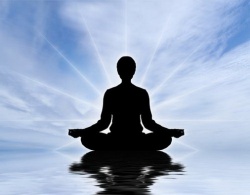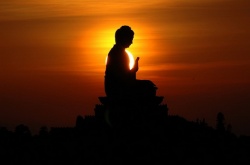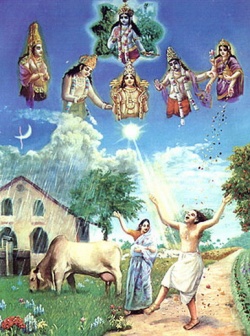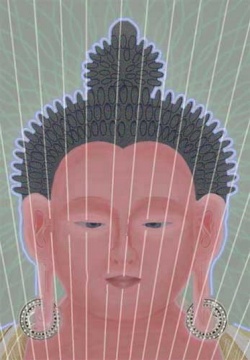Hidden Kingdom
The spiritual center of the World has had different names in different traditions, but in many spiritual systems there is referred to a certain and unique point of emanation of spiritual order, most often described in a way that indicates it being placed in a parallel world or a higher dimension. The Hindus have called it "Paradesha", the Buddhists "Shambhala", the Christians and the Jews the "Garden of Eden". In the esoteric literature it has become known as "Shangri-La", "Agarttha" or "the Land of the Living".
Until now, very few people have penetrated beyond the veil of legend and mystery surrounding this 'Holy Land' of all holy lands. Apollonius of Tyana, 1st century A.D. initiate and spiritual seeker who travelled extensively through India and Tibet and left us many philosophical works of great value.
The Buddhists, mainly in Tibet, maintain a cultural inheritance rich in allusions to Shambala. It is said, that from there came the most important teachings of the Tibetan Buddhist line, such as the Kalachakra Tantra initiation, which is currently being spread in the West by the Dalai Lama. He and the Panchen Lama traditionally function as 'ambassadors' of Shambhala in our world.
Through the ages Shambhala has also manifested on the earthly plane in different cultures of our planet. According to the ancient Vedic scriptures its representation has been held by people such as the Hyperboreans and the Atlanteans (both also described by Plato) and in historic times by the Tibetans. Any true spiritual path works in accordance with teachings from Shambhala, but few are concerned with the direct communication with the inhabitants and rulers of this sacred realm.
Shambhala, known as the “Hidden Kingdom,” is thought of in Tibet as a community, where perfect and semi perfect beings live and are guiding the evolution of humankind. Shambhala is considered to be the source of the Kalacakra, which is the highest and most esoteric branch of Tibetan mysticism.
The Buddha preached the teachings of the Kalacakra to an assembly of holy men in southern India. Afterwards, the teachings remained hidden for 1,000 years until an Indian yogi-scholar went in search of Shambhala and was initiated into the teachings by a holy man he met along the way. The Kalacakra then remained in India until it made its way to Tibet in 1026. Since then the concept of Shambhala has been widely known in Tibet, and Tibetans have been studying the Kalacakra for the least 900 years, learning its science, practicing its meditation, and using its system of astrology to guide their lives. As one Tibetan lama put it, how could Shambhala be the source of something, which has affected so many areas of Tibetan life for so long and yet not exist?
Tibetan religious texts describe the physical makeup of the hidden land in detail.
It is thought to look like and eight-petaled lotus blossom because it is made up of eight regions, each surrounded by a ring of mountains. In the center of the innermost ring lies Kalapa, the capital, and the king palace, which is composed of gold, diamonds, coral, and precious gems. The capital is surrounded by mountains made of ice, which shine with a crystalline light. The technology of Shambhala is supposed to be highly advanced. The palace contains special skylights made of lenses which serve as high-powered telescopes to study extraterrestrial life, and for hundreds of years Shambhala?s inhabitants have been using aircraft and cars that shuttle through a network of underground tunnels. On the way to enlightenment, Shambhalans acquire such powers clairvoyance, the ability to move at great speeds, and the ability to materialize and disappear at will.
Strange sightings in the area where Shambhala is thought to be seem to provide evidence of its existence. Tibetans believe that the land is guarded by beings with superhuman powers. In the early 1900s an article in an Indian newspaper, the Statesman, told of a British major who, camping in the Himalayas, saw a very tall, lightly clad man with long hair. Apparently, noticing that he was being watched, the man leaped down the vertical slope and disappeared. To his astonishment, the Tibetans with whom he was camping showed no surprise at his story; they calmly explained that he had seen one of the snowmen that guard the sacred land.
While people (especially Tibetan lamas) have been searching for Shambhala for centuries, those who seek the kingdom often never return, either because they have found the hidden country and have remained there or because they have been destroyed in the attempt. Tibetan texts containing what appear to be historical facts about Shambhala, such as the names and dates of its kings and records of corresponding events occurring in the outside world, give Tibetans additional reason for believing that the kingdom exists. Recent events that seem to correspond to the predictions of the mythic kingdom add strength to their belief. The disintegration of Buddhism in Tibet and the growth of materialism throughout the world, coupled with the wars and turmoil of the 20th century, all fit in with the prophecy of Shambhala.
Legend
Shambhala is the place where King Sucandra, having come from the north of Kashmir, brought and developed the practice of Kalachakra, after he had received its empowerment and teachings at Dhanyakataka.
Shambhala supposedly can only to be perceived by beings with pure mind and karmic connections.
The prophecy of Shambhala states that each of its kings will rule for 100 years.
There will be 32 in all, and as their reigns pass, conditions in the outside world will deteriorate. Men will become more warlike and pursue power for its own sake, and an ideology of materialism will spread over the earth. When the “barbarians” who follow this ideology are united under an evil king and think there is nothing left to conquer, the mists will lift to reveal the icy mountains of Shambhala. The barbarians will attack Shambhala with a huge army equipped with terrible weapons. Then the 32nd king of Shambhala, Rudra Cakrin, will lead a mighty host against the invaders. In a last great battle, the evil king and his followers will be destroyed.
The Buddha prophesized that all who received the Kalachakra empowerment would take rebirth in its mandala.
[[Category:]]“Wheel of Time”
The outer meaning deals with the universe and all traditional sciences such as astronomy, astrology, mathematics, and medicine. The inner meaning relates to the human body, its internal structure and subtle energies, to be developed through yogas and tantras. The secret meaning refers to the complete cycle of study and practice of the Tantric meditation on the Kalachakra deity and its Mandala.
The “Kalachakra Tantra” is regarded as the essence and heart of Vajrayana. The first king of Shambhala, Sucandra, an emanation of Vajrapani, requested Buddha Sakyamuni to give teachings about Kalachakra. On the full-moon day of the third month, at the stupa of Dhanyakataka in the south of India, before an assembly of innumerable Buddhas, Bodhisattvas, Dakas, Dakinis, gods, nagas and yakshas, the Buddha manifested in the form of Kalachakra, transmitted the complete empowerment and gave teachings on this Tantra, which belongs to the most profound and highest class of Tantras. When back in Shambhala, King Sucandra built up a three dimensional mandala of Kalachakra, absorbed himself in the practice and gave the transmission of the whole cycle to all inhabitants of the kingdom of Shambhala.
Source
www.newsfinder.org [[Category:]]



